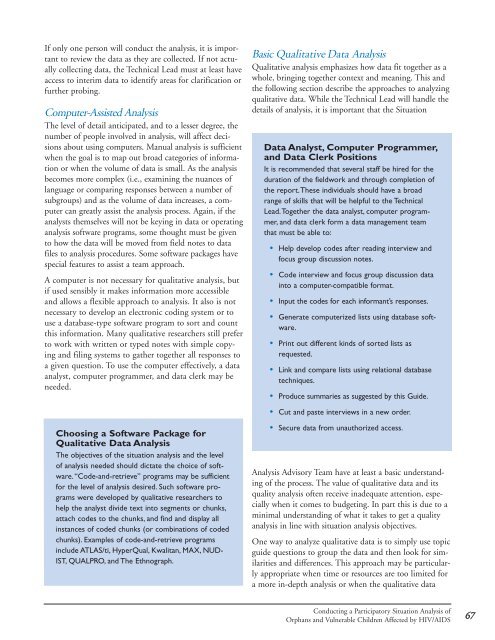Conducting a Participatory Situation Analysis of.pdf - Global HIV ...
Conducting a Participatory Situation Analysis of.pdf - Global HIV ...
Conducting a Participatory Situation Analysis of.pdf - Global HIV ...
Create successful ePaper yourself
Turn your PDF publications into a flip-book with our unique Google optimized e-Paper software.
If only one person will conduct the analysis, it is important<br />
to review the data as they are collected. If not actually<br />
collecting data, the Technical Lead must at least have<br />
access to interim data to identify areas for clarification or<br />
further probing.<br />
Computer-Assisted <strong>Analysis</strong><br />
The level <strong>of</strong> detail anticipated, and to a lesser degree, the<br />
number <strong>of</strong> people involved in analysis, will affect decisions<br />
about using computers. Manual analysis is sufficient<br />
when the goal is to map out broad categories <strong>of</strong> information<br />
or when the volume <strong>of</strong> data is small. As the analysis<br />
becomes more complex (i.e., examining the nuances <strong>of</strong><br />
language or comparing responses between a number <strong>of</strong><br />
subgroups) and as the volume <strong>of</strong> data increases, a computer<br />
can greatly assist the analysis process. Again, if the<br />
analysts themselves will not be keying in data or operating<br />
analysis s<strong>of</strong>tware programs, some thought must be given<br />
to how the data will be moved from field notes to data<br />
files to analysis procedures. Some s<strong>of</strong>tware packages have<br />
special features to assist a team approach.<br />
A computer is not necessary for qualitative analysis, but<br />
if used sensibly it makes information more accessible<br />
and allows a flexible approach to analysis. It also is not<br />
necessary to develop an electronic coding system or to<br />
use a database-type s<strong>of</strong>tware program to sort and count<br />
this information. Many qualitative researchers still prefer<br />
to work with written or typed notes with simple copying<br />
and filing systems to gather together all responses to<br />
a given question. To use the computer effectively, a data<br />
analyst, computer programmer, and data clerk may be<br />
needed.<br />
Basic Qualitative Data <strong>Analysis</strong><br />
Qualitative analysis emphasizes how data fit together as a<br />
whole, bringing together context and meaning. This and<br />
the following section describe the approaches to analyzing<br />
qualitative data. While the Technical Lead will handle the<br />
details <strong>of</strong> analysis, it is important that the <strong>Situation</strong><br />
Data Analyst, Computer Programmer,<br />
and Data Clerk Positions<br />
It is recommended that several staff be hired for the<br />
duration <strong>of</strong> the fieldwork and through completion <strong>of</strong><br />
the report.These individuals should have a broad<br />
range <strong>of</strong> skills that will be helpful to the Technical<br />
Lead.Together the data analyst, computer programmer,<br />
and data clerk form a data management team<br />
that must be able to:<br />
• Help develop codes after reading interview and<br />
focus group discussion notes.<br />
• Code interview and focus group discussion data<br />
into a computer-compatible format.<br />
• Input the codes for each informant’s responses.<br />
• Generate computerized lists using database s<strong>of</strong>tware.<br />
• Print out different kinds <strong>of</strong> sorted lists as<br />
requested.<br />
• Link and compare lists using relational database<br />
techniques.<br />
• Produce summaries as suggested by this Guide.<br />
• Cut and paste interviews in a new order.<br />
Choosing a S<strong>of</strong>tware Package for<br />
Qualitative Data <strong>Analysis</strong><br />
The objectives <strong>of</strong> the situation analysis and the level<br />
<strong>of</strong> analysis needed should dictate the choice <strong>of</strong> s<strong>of</strong>tware.“Code-and-retrieve”<br />
programs may be sufficient<br />
for the level <strong>of</strong> analysis desired. Such s<strong>of</strong>tware programs<br />
were developed by qualitative researchers to<br />
help the analyst divide text into segments or chunks,<br />
attach codes to the chunks, and find and display all<br />
instances <strong>of</strong> coded chunks (or combinations <strong>of</strong> coded<br />
chunks). Examples <strong>of</strong> code-and-retrieve programs<br />
include ATLAS/ti, HyperQual, Kwalitan, MAX, NUD-<br />
IST, QUALPRO, and The Ethnograph.<br />
• Secure data from unauthorized access.<br />
<strong>Analysis</strong> Advisory Team have at least a basic understanding<br />
<strong>of</strong> the process. The value <strong>of</strong> qualitative data and its<br />
quality analysis <strong>of</strong>ten receive inadequate attention, especially<br />
when it comes to budgeting. In part this is due to a<br />
minimal understanding <strong>of</strong> what it takes to get a quality<br />
analysis in line with situation analysis objectives.<br />
One way to analyze qualitative data is to simply use topic<br />
guide questions to group the data and then look for similarities<br />
and differences. This approach may be particularly<br />
appropriate when time or resources are too limited for<br />
a more in-depth analysis or when the qualitative data<br />
<strong>Conducting</strong> a <strong>Participatory</strong> <strong>Situation</strong> <strong>Analysis</strong> <strong>of</strong><br />
Orphans and Vulnerable Children Affected by <strong>HIV</strong>/AIDS<br />
67















